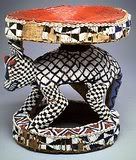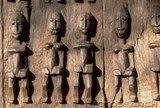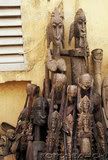Saturday, June 2, 2007
The San - African Bushmen - II
http://en.wikipedia.org/wiki/Bushmen
From Wikipedia, the free encyclopedia
| Bushmen |
|---|
| Total population |
82,000 |
| Regions with significant populations |
| Botswana (55,000), Namibia (27,000) |
| Languages |
| Various Khoisan languages |
| Religions |
| Related ethnic groups |
| Khoikhoi, Xhosa, Zulu, Griqua |
The Bushmen, San, Basarwa or Khwe are indigenous people of the Kalahari Desert, which spans areas of South Africa, Botswana, Namibia and Angola. They were traditionally hunter-gatherers, part of the Khoisan group, and are related to the traditionally pastoral Khoikhoi. Starting in the 1950s through the 1990s they switched to farming, with only minor hunting and gathering activities.[1] Archaeological evidence suggests that they have lived in southern Africa (and probably other areas of Africa) for at least 22,000 years but probably much longer. Genetic evidence suggests they are one of the oldest, if not the oldest, peoples in the world — a "genetic Adam" according to Spencer Wells, from which all humans can ultimately trace their genetic heritage.[2]
Naming
The terms San, Khwe, Bushmen, and Basarwa have all been used to refer to hunter-gatherer peoples of southern Africa. Each of these terms has a problematic history, as they have been used by outsiders to refer to them, often with pejorative connotations. The individual groups identify by names such as Ju/’hoansi and !Kung (the punctuation characters representing different clicks), and most call themselves "Bushmen" when referring to themselves collectively.[3]
The term "San" was historically applied by their ethnic relatives and historic rivals, the Khoikhoi. This term means "outsider" in the Nama language and was derogatory because it distinguished the Bushmen from what the Khoikhoi called themselves, namely the First People.[3] Western anthropologists adopted "San" extensively in the 1970s, where it remains preferred in academic circles. The term "Bushmen" is widely used, but opinions vary on whether it is appropriate – given that the term is sometimes viewed as pejorative.[4][5]
In South Africa, the term "San" has become favored in official contexts, being included in the blazon of the new national coat-of-arms. In South Africa "Bushman" is considered derogatory by some groups. Angola does not have an official term for Bushmen, but they are sometimes referred to as Bushmen, Kwankhala, or Bosquímanos (the Portuguese term for Bushmen). Neither Zambia nor Zimbabwe have official terms, although in the latter case the terms Amasili and Batwa are sometimes used. [6] In Botswana, the officially used term is Basarwa[7], where it is partially acceptable to some Bushmen groups, although Basarwa, a Tswana language label, also has negative connotations. The term used to be used in the plural, "Masarwa," but this is now almost universally considered offensive.[6]
Relocation and government persecution
Since the mid-1990s the central government of Botswana has been trying to move Bushmen out of the Central Kalahari Game Reserve even though the national constitution guarantees the Bushmen the right to live there in perpetuity. The Game Reserve was originally created in 1961 to protect the 5,000 Bushmen living there who were being persecuted by farmers and cattle-rearing tribes. The government's position is that it is too costly to provide even such basic services as medical care and schooling, despite the reserve's tourism revenues. It has banned hunting with guns in the reserve and has said that the Bushmen threaten the reserves ecology. Others, however, claim that the government's intent is to clear the area – an area the size of Denmark – for the lucrative tourist trade and for diamond mining. As of October 2005, the government has resumed its policy of forcing all Bushmen off their lands in the Game Reserve, using armed police and threats of violence or death.[8] Many of the involuntarily displaced Bushmen live in squalid resettlement camps and some have resorted to prostitution, while about 250 others remain or have surreptitiously returned to the Kalahari to resume their independent lifestyle.
The group as a whole has little voice in the national political process and is not one of the tribal groups recognized in the constitution of Botswana. Over the generations, the Bushmen of South Africa have continued to be absorbed into the African population, particularly the Griqua sub-group, which is an Afrikaans-speaking people of predominantly Khoisan that has certain unique cultural markers that set them apart from the rest of the Africans.
On December 13, 2006, the Bushmen won an historic ruling in their long-running court case against the government. By a 2-1 majority, the court said the refusal to allow the Basarwa into the Central Kalahari Game Reserve (CKGR) without a permit was "unlawful and unconstitutional." It also said the state's refusal to issue special game licenses to allow the Bushmen to hunt was "unlawful" and "unconstitutional" and found that the Bushmen were "forcibly and wrongly deprived of their possessions" by the government. However, the court did not compel the government to provide services such as water to any Bushmen who returned to the reserve. More than one thousand Bushmen intend to return to the Central Kalahari Game Reserve, one of Africa's largest protected nature reserves.[9]
Society
The Bushman kinship system reflects their interdependence as traditionally small, mobile foraging bands. Also, the kinship system is comparable to the Eskimo Kinship system, with the same set of terms as in Western countries, and also employ a name rule and an age rule. The age rule resolves any confusion arising around kinship terms, because the older of two people always decides what to call the younger. According to the name rule, if any two people have the same name, for example an old man and a young man both named /Twi, each family uses the same kin term to refer to them: Young /Twi's mother could call Old /Twi "son", Old /Twi would address young /Twi's sister as his own, Young /Twi would call Old /Twi's wife "wife", and Old /Twi's daughter would be strictly forbidden to Young /Twi as a potential bride. Since relatively few names circulate, and each child is named for a grandparent or other relative, Bushmen are guaranteed an enormous family group with whom they are welcome to travel.
Traditional gathering gear is simple and effective: a hide sling, blanket, and cloak called a kaross to carry foodstuffs, firewood, or young children, smaller bags, a digging stick, and perhaps a smaller version of the kaross to carry a baby. Women and men would gather, and men hunted using poison arrows and spears in laborious days-long excursions.
Villages ranged in sturdiness from nightly rain shelters in the warm spring, when people moved constantly in search of budding greens, to formalized rings when they congregated in the dry season around the only permanent waterholes. Early spring, a hot dry period following a cool dry winter, was the hardest season, after autumn nuts were exhausted, villages concentrated around waterholes, and most plants were dead or dormant. Meat was most important in the dry months, when wildlife could never range far from receding waters.
Traditionally the San possessed no status hierarchies[10]. They had no "chief" but instead made decisions among themselves, on a consensus basis. Women's status was relatively equal[11]. Women did not begin bearing children until about 18 or 19 years of age due to late first menstruation due to the low calorie and low fat diet [12] and had them spaced four years apart, due to lack of enough breast milk to feed more than one child at a time [13], and the requirements of mobility leading to the difficulty of carrying more than one child at a time.
Children were very well behaved and treated kindly by the their parents and group[14]. Children spent much of the day playing with each other and are not segregated by sex, neither sex is trained to be submissive or fierce, and neither sex is restrained from expressing the full breadth of emotion that seems inherent in the human spirit" [15].
The San economy was a gift economy, based on giving each other gifts on a regular basis rather than on trading or purchasing goods and services [16].


Early history
Bushmen had an advanced early culture evidenced by archaeological data. For example, Bushmen from the Botswana region migrated south to the Waterberg Massif in the era 10,000 to 20,000 years ago. They left rock paintings at the Lapala Wilderness area and Goudriver recording their life and times, including characterizations of rhinoceros, elephant and a variety of antelope species (resembling impala, kudu and eland, all present day inhabitants).
In the media
The Bushmen of the Kalahari were first brought to the Western world's attention in the 1950s by South African author Laurens van der Post with the famous book The Lost World of the Kalahari, which was also a BBC TV series.
The 1980 comedy movie The Gods Must Be Crazy portrays a Kalahari Bushman tribe's first encounter with an artifact from the outside world (a Coke bottle).
John Marshall documented the lives of Bushmen in the Nyae Nyae region of Namibia over more than a 50-year period. His early film The Hunters, released in 1957, shows a giraffe hunt during the 1950s. N!Ai: The Story of a !Kung Woman (1980) is the account of a woman who grew up while the Bushmen were living as autonomous hunter-gatherers and was later forced into a dependent life in the government created community at Tsumkwe. A Kalahari Family (2002) is a five-part, six-hour series documenting 50 years in the lives of the Ju/’hoansi of Southern Africa, from 1951 to 2000. Marshall was a fierce and vocal proponent of the Bushman cause throughout his life, which was, in part, due to strong kinship ties, and had a Bushmen wife in his early 20s.[17]
In Wilbur Smith's The Burning Shore, the San people are portrayed through two major characters, O'wa and H'ani, and the Bushmen's struggles, history and beliefs are touched upon in great detail. The Burning Shore is a volume in the Courtney's of Africa series.
PBS's series How Art Made the World compares San cave painting 200 years ago to Paleolithic European painting 14,000 years old. Because of their similarities, the San can help us understand the reasons for ancient cave paintings. Lewis Williams believes that their trance states (traveling to the spirit world) are directly related to the reasons people went deep into caves, experienced sensory deprivation, and painted their visions onto the cave walls.
Spencer Wells' 2003 book The Journey of Man—in connection with National Geographic's Genographic Project—discusses a genetic analysis of the San and asserts their blood contains the oldest genetic markers found on earth, making the Bushmen humankind's "genetic Adam". These genetic markers are present on the y chromosome and are therefore passed down through thousands of generations in a relatively pure form. The documentary continues to trace these markers throughout the world, demonstrating that all of humankind can be traced back to the African continent and that the San are the last, most genetically unadulterated, remnant of humankind's ancient ancestors.
Notables
- Autshumato ("Harry")
- Krotoa ("Eva") Pikki pikki what was a famous tribe.
- N!xau starred in several films based off and including The Gods Must Be Crazy.
See also
Notes
- ^ Elizabeth Marshall Thomas (2006). The Old Way. ISBN 0374225524. Chapter 20 "The Present".
- ^ Spencer Wells (2003). The Journey of Man. ISBN 069111532X. Pg. 56-58
- ^ a b Elizabeth Marshall Thomas (2006). The Old Way. Chapter "About Words and Names". ISBN 0374225524.
- ^ Sailer, S (2002). Name Game Inuit or Eskimo. Retrieved on 2006-11-15.
- ^ "Wrong Term for the Kalahari's People", Washington Post, 7 June, 2005
- ^ a b Hitchcock, Robert K., and Megan Biesele. "San, Khwe, Basarwa, or Bushmen?: Terminology, Identity, and Empowerment in Southern Africa." Kalahari Peoples Fund. 28 December 2000
- ^ Botswana Gov. - Basarwa Relocation - Intro
- ^ Bushmen forced out of desert after living off land for thousands of years. The Daily Telegraph. Retrieved on 2005-10-29.
- ^ Botswana's bushmen get Kalahari lands back. CNN. Retrieved on 2006-12-13.
- ^ Marjorie Shostak, 1983, Nisa: The Life and Words of a !Kung Woman. New York: Vintage Books. Page 10.
References
- Elizabeth Marshall Thomas (2006). The Old Way: A Story of the First People.
- Marjorie Shostak (1983). Nisa: The Life and Words of a !Kung Woman. New York: Vintage Books.
- Nancy Howell. (1979). Demography of the Dobe !Kung. New York: Academic Press.
- Richard Lee and Irvin DeVore (1999). Kalahari Hunter-Gatherers: Studies of the !Kung San & Their Neighbors. iUniverse.
- Robert J. Gordon (1999). The Bushman Myth: The Making of a Namibian Underclass. ISBN 0813335817.
External links
- Official Botswana Government Website
- Survival International
- National Geographic
- Photo Gallery of Bushmanland, Namibia Over 200 photographs of Ju/'hoansi Bushmen and landscape
- Bleek and Lloyd Archive of xam and !kun texts online
- Specimens of Bushmen folklore - tales collected by Bleek and Lloyd
- The San Trickster God meets the Ideology of the West: Exploring the Implications of Interpretation among San and European Relations in Southern Africa
- The myth of ritual origins? Ethnography, mythology and interpretation of San rock art by Dr Anne Solomon (South African Archaeological Bulletin, June 1997)
- The Kalahari Peoples Fund
- Scientific American - Offerings to a Stone Snake Provide the Earliest Evidence of Religion by J. R. Minkel 01/12/06
Labels: The San African Bushmen - II
Subscribe to Comments [Atom]











